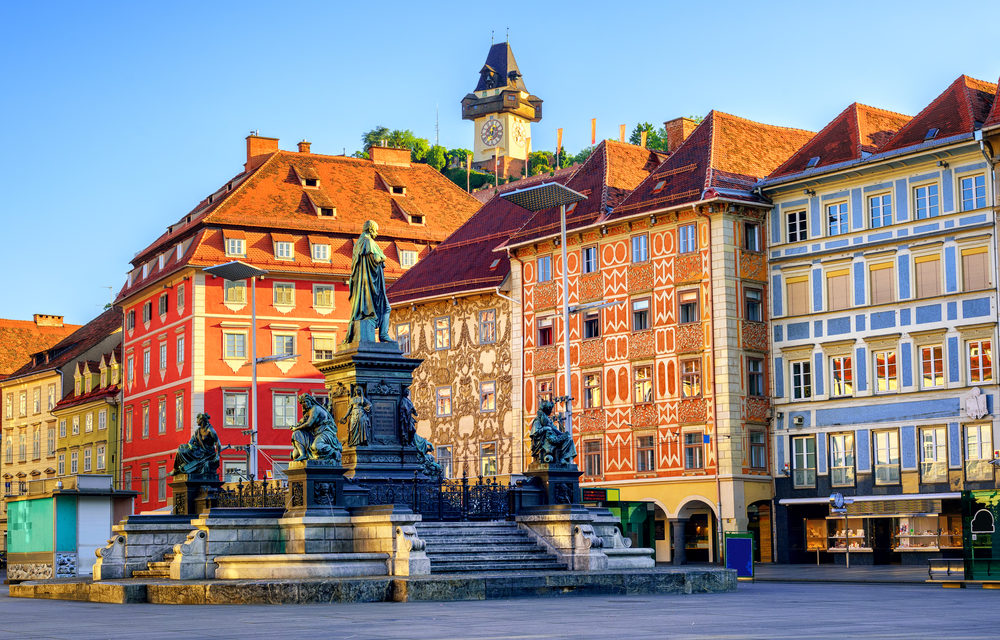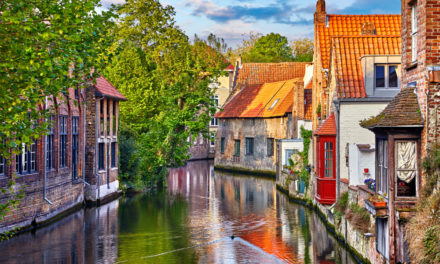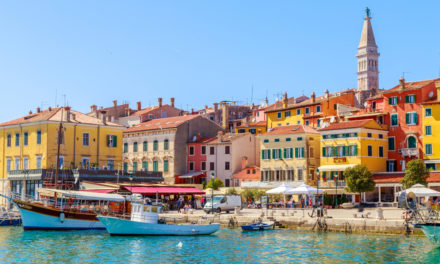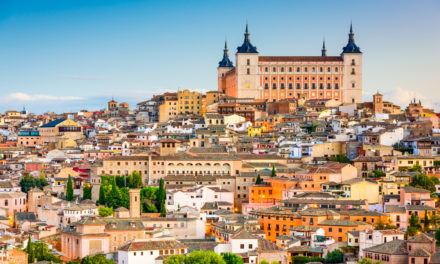Top Tourist Attractions And Things To Do In Austria
Austria is a small, landlocked country renowned for its alpine scenery, excellent museums, charming streets, and vibrant Christmas markets.
Austria is a hub for music lovers as Mozart’s birthplace, a culinary destination famous for its Wienerschnitzel, and an outdoor paradise offering activities like paragliding, rafting, and hiking in its stunning landscape.
We’ve curated a list of “Best Places to Visit in Austria” to ensure your journey is truly unforgettable.
Tourist Travel Map of Austria
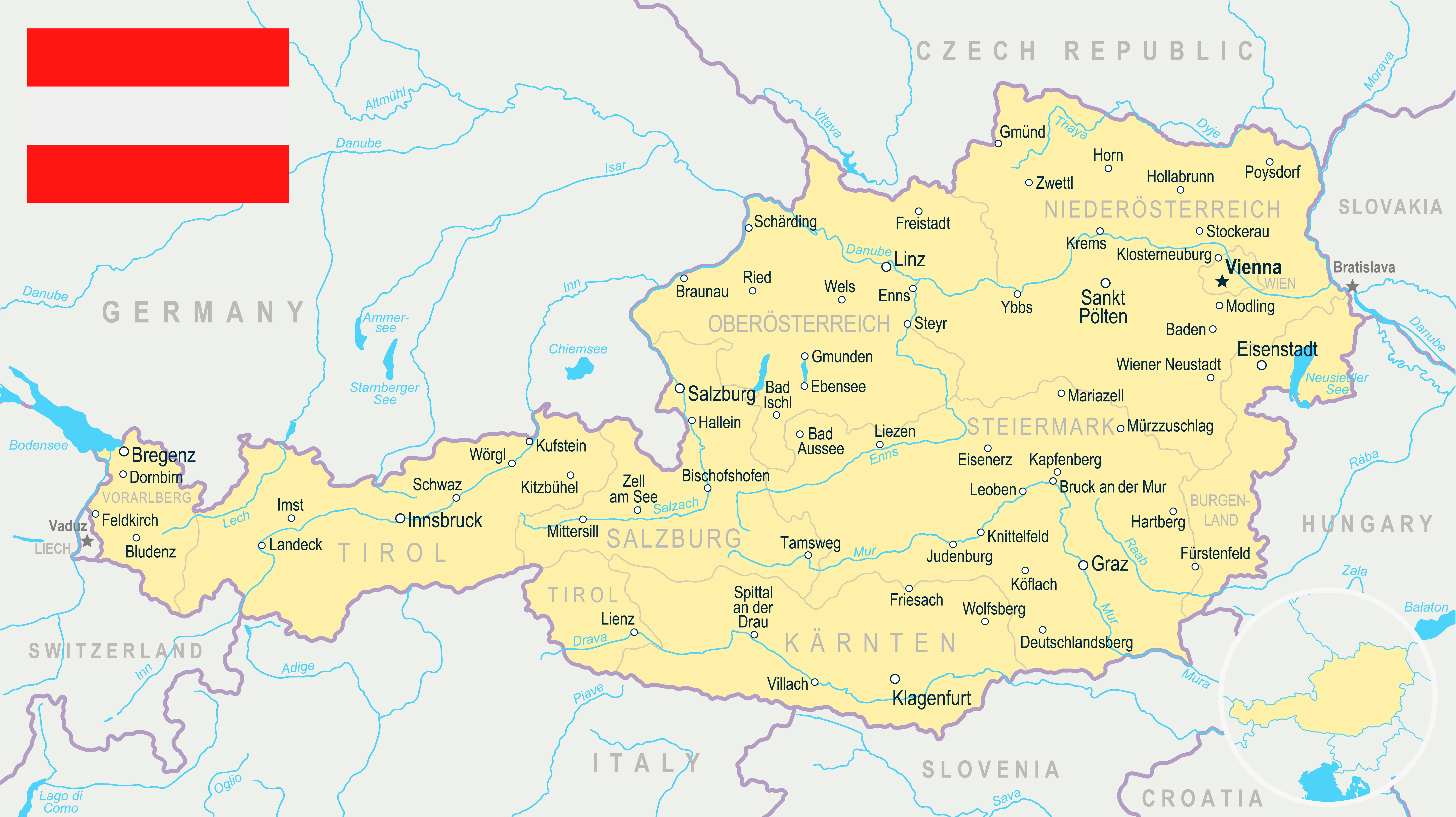
Best Places To Visit In Austria
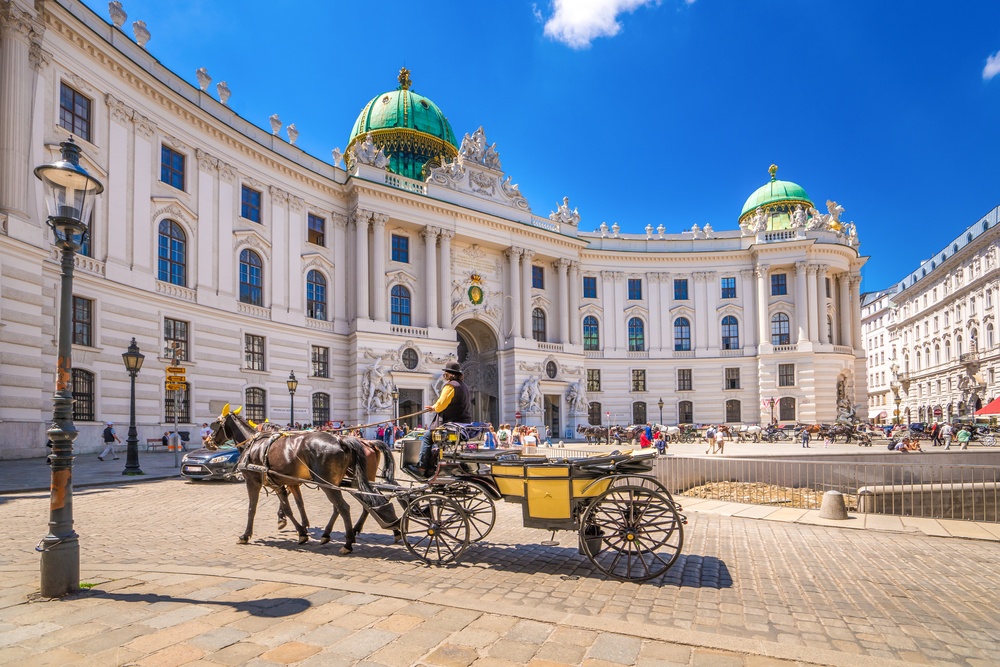
Vienna, Austria:
Vienna, Austria’s capital, is known for its cultural events, imperial sights, coffee houses, cozy wine taverns, and the very special Viennese charm. Vienna owes much of its charm and rich history to its splendid location on the banks of the mighty Danube River.
For centuries, the gateway between West and East Europe, it’s a city as dynamic as it is historic. It has an impressive roster of old-world palaces, museums, and markets, vibrant nightlife, trendy shops, and cool cafes.
How to Reach Vienna:
As the capital city, Vienna is conveniently nestled in northeastern Austria along the banks of the Danube River. The city boasts an extensive public transport system, making hopping between historic sites and modern hotspots easy.
Number of Days to Visit Vienna:
With abundant attractions, allocate at least 3 to 4 days to immerse yourself in Vienna’s rich cultural fabric.
Tourist Attractions and Things to Do in Vienna:
- Schönbrunn Palace: A baroque masterpiece and former imperial residence.
- Vienna State Opera: A prime venue for world-class opera and ballet.
- Naschmarkt: A bustling market offering diverse culinary delights.
- Belvedere Palace: Renowned for its art collection, including Klimt’s “The Kiss.”
- Prater: An amusement park with the iconic Riesenrad Ferris wheel.
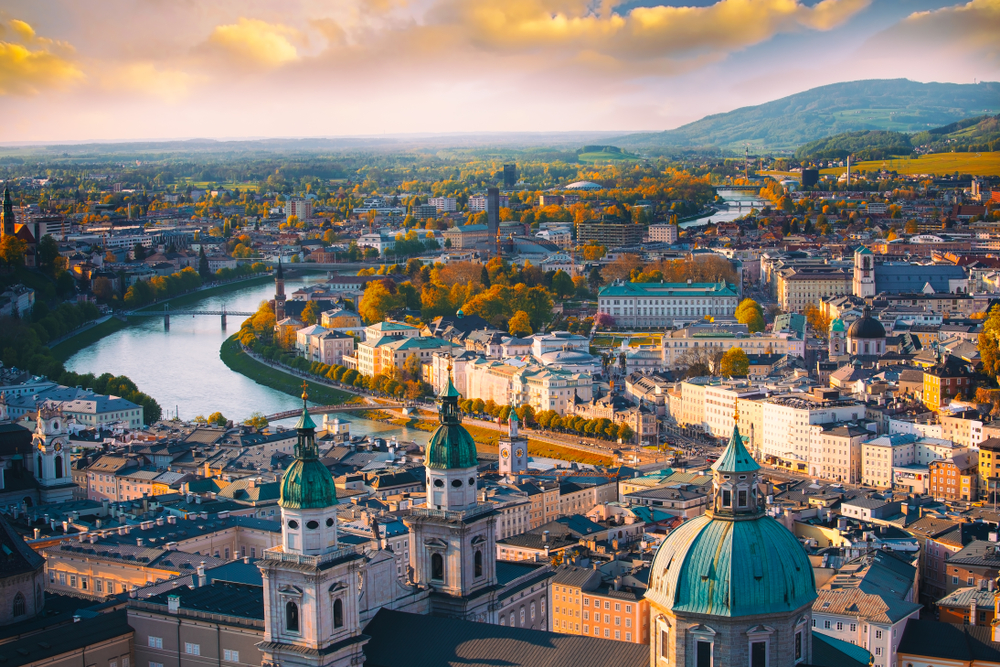
Salzburg, Austria:
Salzburg offers historic architecture and stunning natural beauty in Austria’s alpine landscapes. This city, the birthplace of Mozart, resonates with musical heritage, evident in its elegant streets and baroque buildings. Salzburg offers charming Old Town, a UNESCO World Heritage site, where centuries-old structures stand beside bustling cafes and shops.
Hohensalzburg Fortress, a majestic castle, offers panoramic views of the city and surrounding mountains. This destination is a haven for those seeking a deep dive into history, culture, and natural splendor, all within a walkable and welcoming urban setting.
How to Reach Salzburg:
Situated in northern Austria near the German border, Salzburg is about a two-hour train ride from Vienna. The city lies beside the Salzach River, surrounded by lush hills and historic fortifications.
Number of Days to Visit Salzburg:
A 2 to 3-day visit provides ample time to explore the city’s top attractions and hidden gems.
Tourist Attractions and Things to Do in Salzburg:
- Hohensalzburg Fortress: One of the largest medieval castles in Europe, offering panoramic views.
- Mirabell Palace and Gardens: A feast for the eyes with intricately designed gardens and architecture.
- Getreidegasse: A shopping street known for its narrow, medieval buildings and Mozart’s birthplace.
- Salzburg Cathedral: A 17th-century baroque cathedral with awe-inspiring interiors.
- Hellbrunn Palace: Famous for its trick fountains and beautiful gardens.
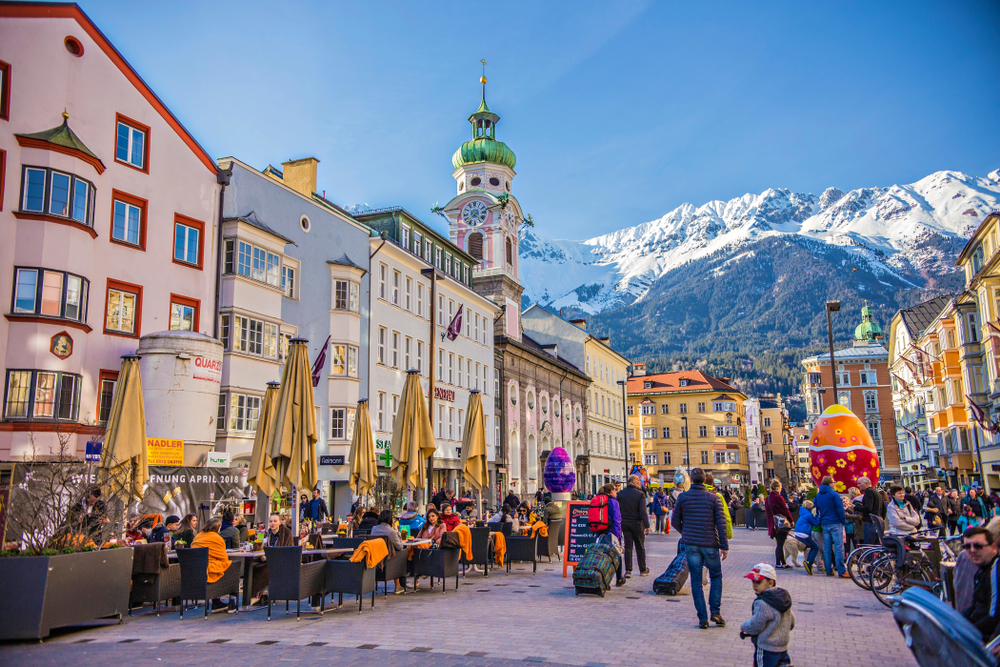
Innsbruck, Austria:
Innsbruck, nestled in Austria’s Tyrol region, is a destination that appeals to both city slickers and nature lovers with its Alpine vistas and urban landscapes.
Its medieval Old Town exudes charm, while the surrounding mountains offer excellent skiing, snowboarding, and hiking opportunities. The Nordkette Mountains, reachable by cable car, provide breathtaking views and easy access to nature. Culturally vibrant, Innsbruck hosts many festivals and boasts a diverse culinary scene, making it a top destination in Austria.
How to Reach Innsbruck:
Innsbruck is the capital of Tyrol and a quick two-hour drive from both Munich and Salzburg. The city is set against the stunning backdrop of towering peaks, offering easy access to outdoor adventures.
Number of Days to Visit Innsbruck:
A stay of 2 to 3 days gives you enough time to appreciate Innsbruck’s multifaceted attractions.
Tourist Attractions and Things to Do in Innsbruck:
- Nordkette: A mountain range offering skiing, hiking, and sweeping views.
- Golden Roof: An iconic landmark with 2,657 fire-gilded copper tiles.
- Ambras Castle: A Renaissance castle with historic collections.
- Hofkirche: A gothic church known for its life-sized bronze statues.
- Swarovski Crystal Worlds: An artful exhibition of crystals, gardens, and installations.
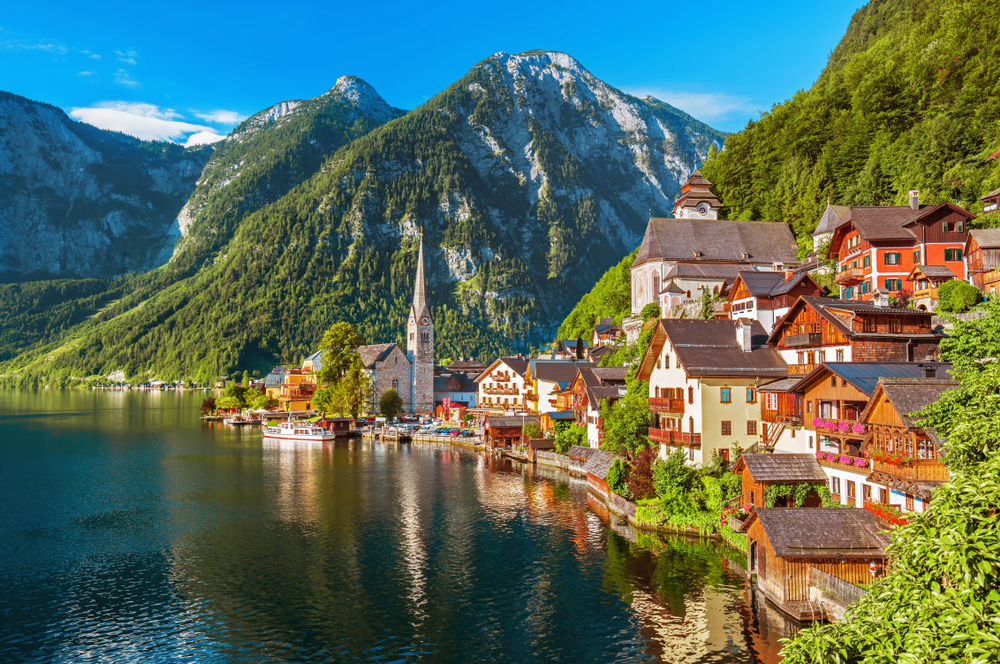
Hallstatt, Austria:
Quaint, peaceful, and unbelievably photogenic, Hallstatt offers the kind of beauty that belongs on postcards. It’s a dream destination for those who equally appreciate architecture and natural splendor.
Hallstatt is a must-visit destination in Austria for a tranquil retreat surrounded by natural beauty.
How to Reach Hallstatt:
Located in the Salzkammergut region, Hallstatt is a four-hour drive from Vienna and just over two hours from Salzburg. Nestled beside Hallstätter See, the town is famed for its charming lake views and mountainous backdrop.
Number of Days to Visit Hallstatt:
A 1 to 2-day stay is usually sufficient to soak in Hallstatt’s enchanting ambiance.
Tourist Attractions and Things to Do in Hallstatt:
- Hallstatt Salt Mines: Known as the “Man in Salt,” these mines are among the world’s oldest.
- Dachstein Ice Caves: A mesmerizing natural wonder, perfect for adventure seekers.
- Market Square: The heart of the town, replete with cafes and souvenir shops.
- Parish of the Assumption: A charming church offering panoramic lake views.
- Hallstatt Skywalk: A lookout point offering breathtaking aerial views of the town.
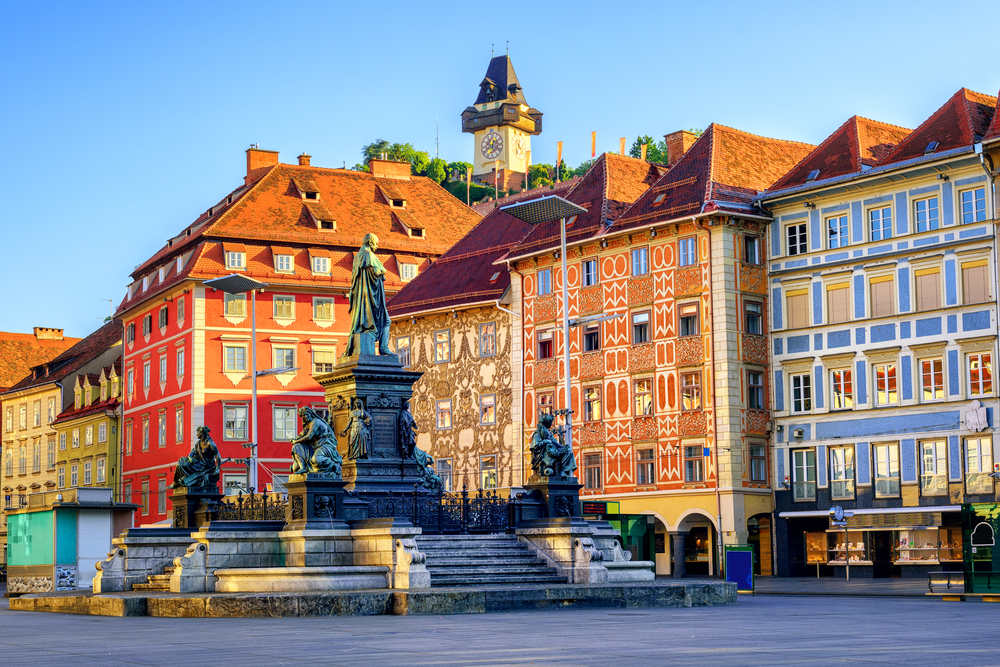
Graz, Austria:
Graz, the Styrian capital and Austria’s second-largest city, boasts a diverse architectural landscape and is renowned as Austria’s culinary capital.
The city skillfully blends its rich historical heritage with contemporary vibes, showcasing stunning architecture spanning various eras. Its pleasant, warm climate, influenced by its proximity to the Mediterranean, makes Graz an attractive destination for visitors.
How to Reach Graz:
Situated in the southeastern part of Austria, Graz is about a two-hour drive from Vienna and less than an hour from the Slovenian border. The city sits on the Mur River, surrounded by rolling hills and vineyards.
Number of Days to Visit Graz:
A 2 to 3-day stay offers a comprehensive Graz experience, from culinary delights to architectural wonders.
Tourist Attractions and Things to Do in Graz:
- Schlossberg: An elevated fortress offering panoramic city views.
- Graz Art Museum: A must-see for modern art enthusiasts.
- Murinsel: An artificial island and a hot spot for events.
- Eggenberg Palace: A Baroque palace with lush gardens.
- Old Town: A UNESCO World Heritage site full of historic buildings.
Want to Explore Top Destinations in Europe?
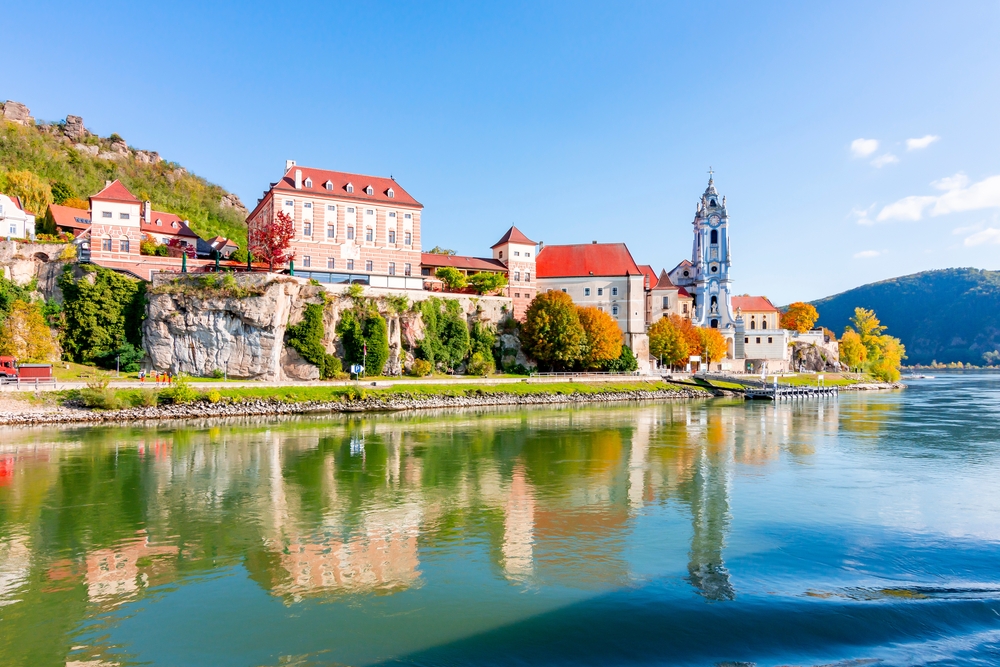
Wachau Valley, Austria:
The Wachau Valley is popular among wine enthusiasts and history buffs, crowned with medieval castles and terraced vineyards. The region has some of Austria’s best wines.
Tourism thrives here, with a boat trip along the Danube River offering unforgettable experiences. Additionally, the cultural landscape of the Danube Valley between Melk and Krems is recognized as a UNESCO World Cultural Heritage site.
How to Reach Wachau Valley:
The Wachau Valley is about an hour’s drive west of Vienna, stretching along the Danube River between Melk and Krems.
Number of Days to Visit Wachau Valley:
A single day can cover the main highlights, but 2 to 3 days are ideal for wine tasting and castle hopping.
Tourist Attractions and Things to Do in Wachau Valley:
- Melk Abbey: An imposing Baroque monastery with an elaborate library.
- Dürnstein Castle: Ruins offering panoramic views over the valley.
- Wine Tastings: Visit local wineries to taste the region’s famed Grüner Veltliner and Riesling.
- Danube Cruises: A leisurely way to see the valley from the water.
- Apricot Orchards: Don’t miss the local apricot delicacies
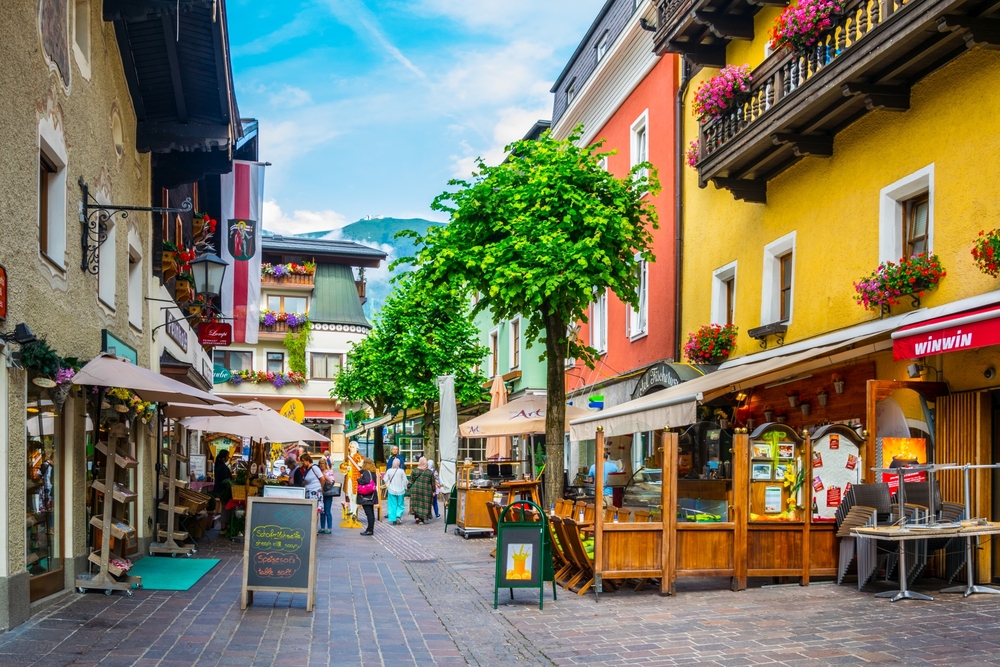
Zell am See, Austria:
Zell am See is a playground for all seasons, offering stunning lake vistas, alpine slopes, and adventure-filled activities.
It’s a haven for outdoor enthusiasts year-round. Zell am See in Austria is an all-season travel treasure for a getaway that promises alpine adventure and lake-side leisure.
How to Reach Zell am See:
The town is about 80 miles south of Salzburg and is easily accessible by car or train.
Number of Days to Visit Zell am See:
A 3- to 4-day visit allows you to explore the town and the surrounding natural wonders, regardless of season.
Tourist Attractions and Things to Do in Zell am See:
- Lake Zell: For swimming, boating, or winter ice skating.
- Schmittenhöhe: Ski, hike, or enjoy the panoramic views.
- Kaprun Glacier: Offers year-round skiing.
- Pinzgauer Lokalbahn: Scenic train rides through the Pinzgau region.
- St. Hippolyte’s Church: A Romanesque beauty with Gothic elements.
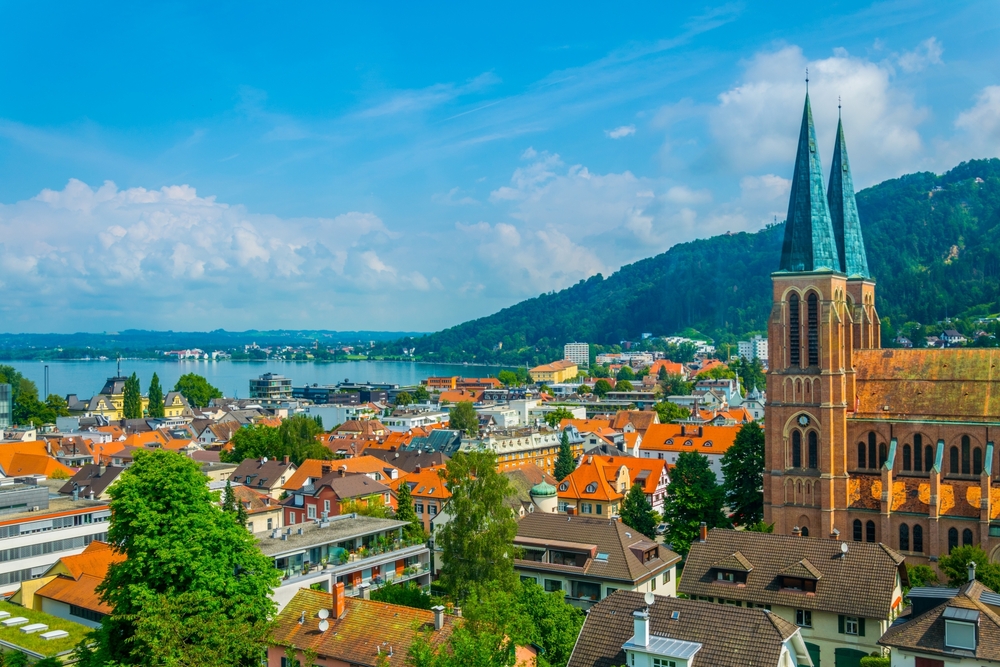
Bregenz, Austria:
Nestled by the shimmering waters of Lake Constance, Bregenz offers a rare blend of cultural richness and natural beauty. It’s the ideal spot for art lovers and water enthusiasts alike. For a combination of vibrant cultural scenes and stunning lake views, Bregenz, Austria, stands as an enticing escape for all kinds of travelers.
How to Reach Bregenz:
Situated at the western edge of Austria, bordering Switzerland and Germany, Bregenz is the capital of the Vorarlberg region. The town is a 2-hour train ride from Innsbruck and equally accessible from Zurich.
Number of Days to Visit Bregenz:
Two days are enough to see the main attractions, but a 3 to 4-day stay will let you thoroughly soak in the lakeside atmosphere and cultural offerings.
Tourist Attractions and Things to Do in Bregenz:
- Pfänder Mountain: Offers panoramic views of Lake Constance and the Alps.
- Bregenz Festival: A world-renowned summer music festival.
- Kunsthaus Bregenz: Showcases contemporary art in a striking modern building.
- Lake Constance: Perfect for sailing, swimming, or a leisurely walk along the shore.
- Martinsturm Tower: An iconic landmark that houses the city’s local history museum.
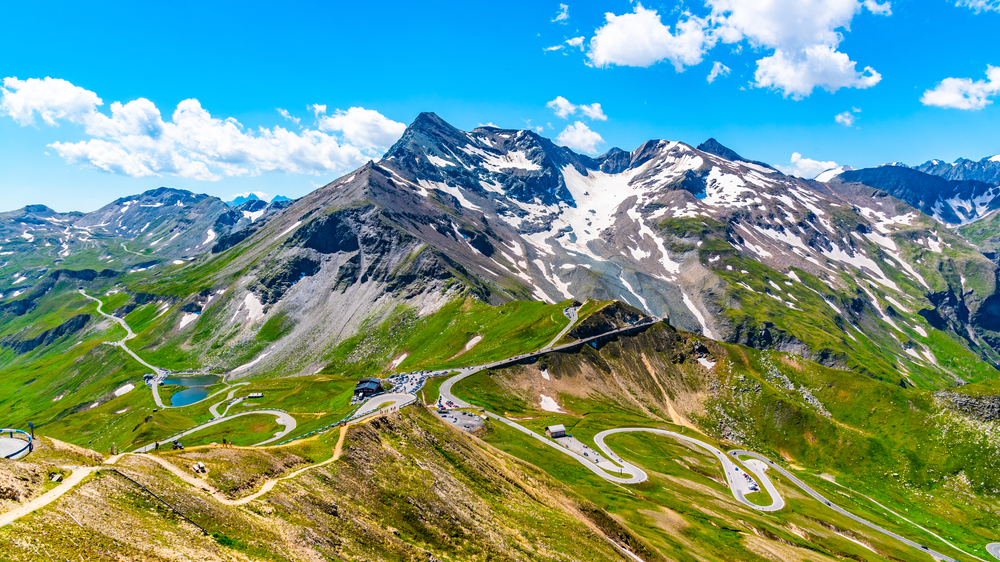
Grossglockner Alpine Road, Austria:
Meandering through lush valleys and snow-capped peaks, Grossglockner Alpine Road is a winding path to pure adrenaline and awe-inspiring vistas. It’s the ultimate driving experience for thrill-seekers and nature lovers.
How to Reach Grossglockner Alpine Road:
This iconic road is located in Salzburg, extending to Carinthia. It starts from Bruck an der Großglocknerstraße, approximately 60 miles south of Salzburg.
Number of Days to Visit Grossglockner Alpine Road:
The drive can be done in a day, but for hiking, photography, and soaking in the views, plan a 2-day adventure.
Tourist Attractions and Things to Do in Grossglockner Alpine Road:
- Edelweißspitze: A viewing platform that offers 360-degree views of alpine peaks.
- Fuscher Törl: An elevated point that closely looks at the Grossglockner itself.
- Glocknerhaus: A historical inn with regional cuisine and local charm.
- Pasterze Glacier: Witness the grandeur of one of the Eastern Alps’ last glaciers.
- High Alpine Nature Park: Explore the diverse flora and fauna along the route.
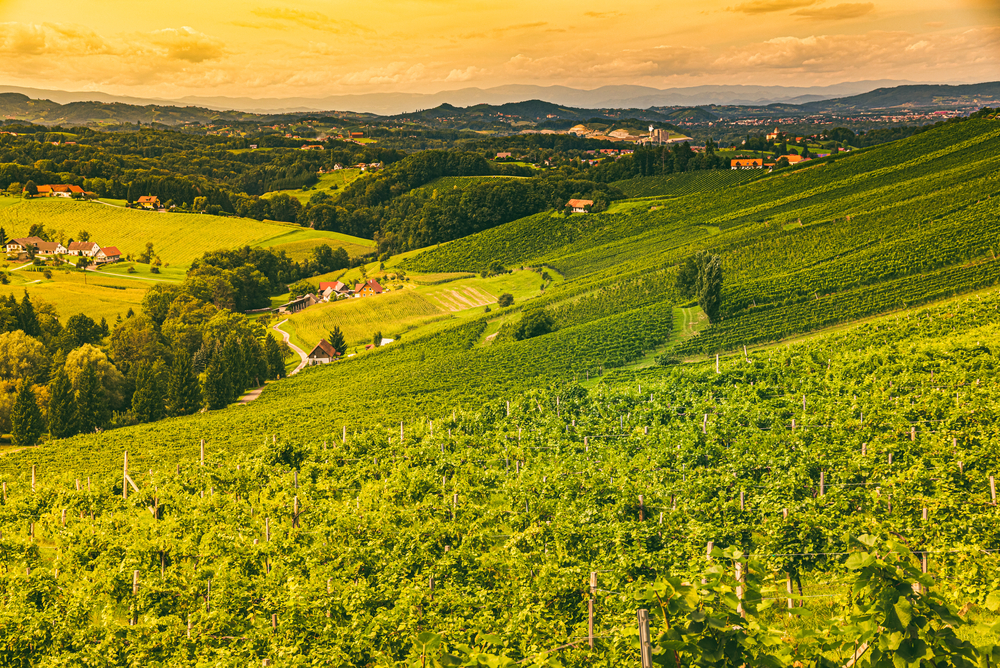
Styrian Wine Road, Austria:
Swaying vineyards, rustic wineries, and rolling hills define the Styrian Wine Road. This route is the perfect destination for anyone looking to sip exquisite wines while soaking up idyllic landscapes. For wine enthusiasts and romantics seeking the serene backdrop of vineyard landscapes, Styrian Wine Road offers a delightful Austrian getaway.
How to Reach Styrian Wine Road:
Located in the southern part of Styria, the wine road stretches approximately 44 miles, starting from Ehrenhausen and ending in Leutschach.
Number of Days to Visit Styrian Wine Road:
A leisurely 3-day trip allows you ample time to visit vineyards, explore villages, and enjoy local culinary delights.
Tourist Attractions and Things to Do in Stryrian Wine Road, Austria:
- Südsteirische Weinstrasse: This is the heart of the wine road, renowned for its Sauvignon Blanc.
- Gamlitz: Known for its wine and motor museums, it’s a cultural gem.
- Schloss Seggau: A historical castle where you can taste some of Styria’s best wines.
- Klapotetz: These unique windmills scattered across the vineyards are not just for show—they’re used to keep birds away.
- Wine Tasting Tours: Many wineries offer guided tours and tastings, a must-do experience.
Ready to Explore Top Destinations in North America?
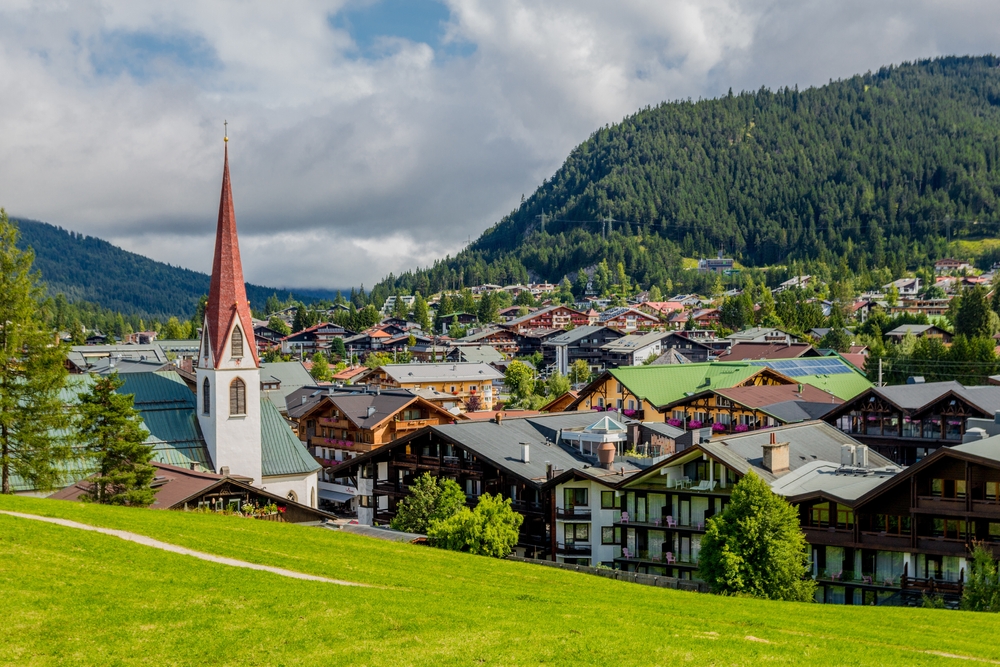
Seefeld in Tyrol, Austria:
Surrounded by mountain peaks and dense pine forests, Seefeld in Tyrol is a haven for outdoor adventurers and those seeking Alpine tranquility. From skiing to hiking, this Austrian resort area is a year-round playground.
How to Reach Seefeld in Tyrol:
Nestled in the western part of Austria, Seefeld in Tyrol sits about 12 miles north of Innsbruck, making it easily accessible by train or car.
Number of Days to Visit Seefeld in Tyrol:
Plan a 4-day stay to dive into the range of outdoor activities and local culture.
Tourist Attractions and Things to Do in Tyrol:
- Rosshütte Ski Area: Offering slopes for all skill levels, this is a winter wonderland.
- Seefeld Wildsee: A picturesque lake ideal for summer swimming and paddleboarding.
- St. Oswald Church: A stunning example of Tyrolean architecture.
- Golfclub Seefeld-Wildmoos: This 18-hole course is set against a mountainous backdrop for the golfers.
- Leutasch Spirit Gorge: A mystical, narrow gorge with footbridges perfect for hiking.
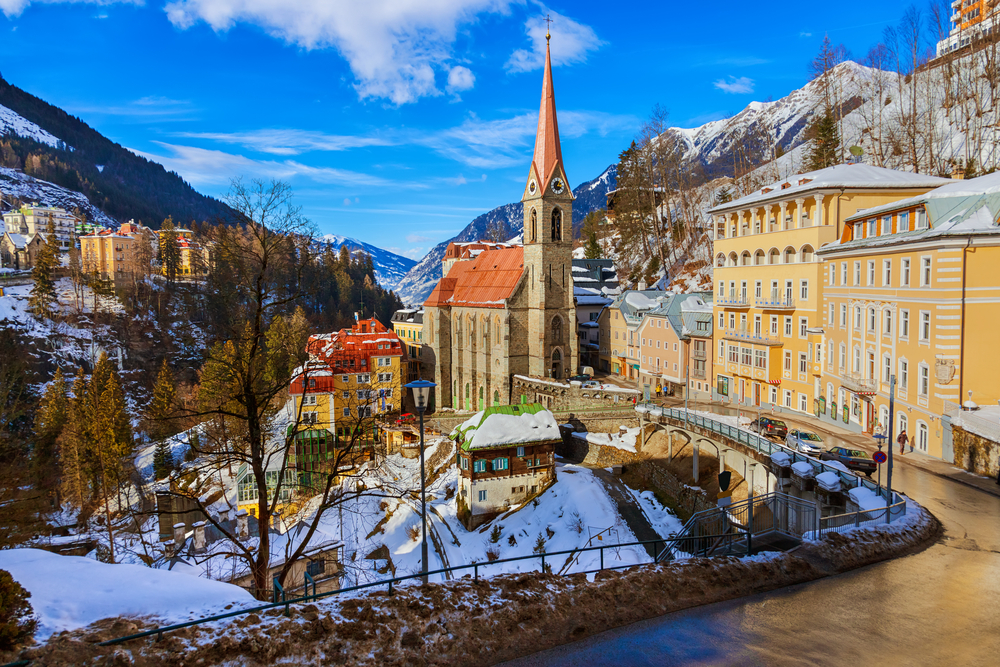
Bad Gastein, Austria:
In the heart of Hohe Tauern National Park in the Salzburg region, Bad Gastien attracts visitors year-round. Winter draws ski enthusiasts, while summer offers hiking, running, Nordic walking, biking, and bike tours in the surrounding national park.
The town center, perched around the Gastein Falls at about 1,000 meters (3,300 feet) above sea level, is notable for its historic, multi-story hotel buildings on steep slopes.
How to Reach Bad Gastein:
Perched in the High Tauern mountains in Salzburg state, Bad Gastein is about a 1.5-hour drive south of Salzburg city.
Number of Days to Visit Bad Gastein:
A 3 to 4-day stay will give you enough time to explore the spas, trails, and historical sites.
Tourist Attractions and Things to Do in Bad Gastein:
- Felsenbad Spa: Immerse yourself in thermal pools with mountain views.
- Stubnerkogel: The highest mountain accessible by gondola, offering panoramic vistas.
- Gastein Waterfall: This 200-meter waterfall is the town’s crowning jewel.
- Gastein Heilstollen: A radon therapy center located inside a mine.
- Hiking Trails: Countless trails beckon, ranging from family-friendly to challenging.
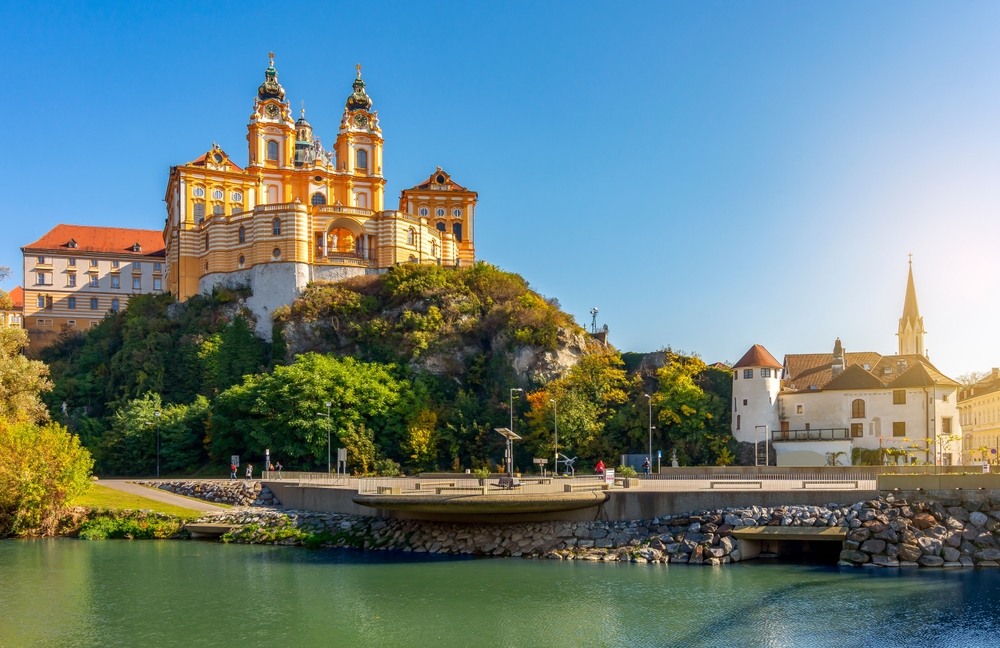
Melk Abbey, Austria:
Melk Abbey is a stunning historical landmark located in Melk, Austria. It’s a massive Baroque-style monastery that has stood for centuries, dating back to around 1089.
The abbey is famous for its magnificent church, with golden decorations and intricate frescoes adorning its walls and ceilings.
Melk Abbey symbolizes Austria’s rich cultural heritage, attracting thousands of yearly visitors.
How to Reach Melk Abbey:
Situated in Lower Austria, Melk Abbey is about an hour’s drive west from Vienna, making it an ideal day-trip destination.
How Much Time to Visit Melk Abbey:
One day is generally sufficient to explore the abbey, its gardens, and its library.
Tourist Attractions and Things to Do in Melk Abbey, Austria:
- Baroque Architecture: The abbey is a masterpiece of Baroque style, inside and out.
- Abbey Library: Home to countless medieval manuscripts and frescoes.
- Marble Hall: An opulent room with a ceiling fresco and panoramic windows.
- Abbey Church: A spiritual core with stunning altars and pulpit.
- Gardens and Terrace: Offering breathtaking views of the Danube Valley.
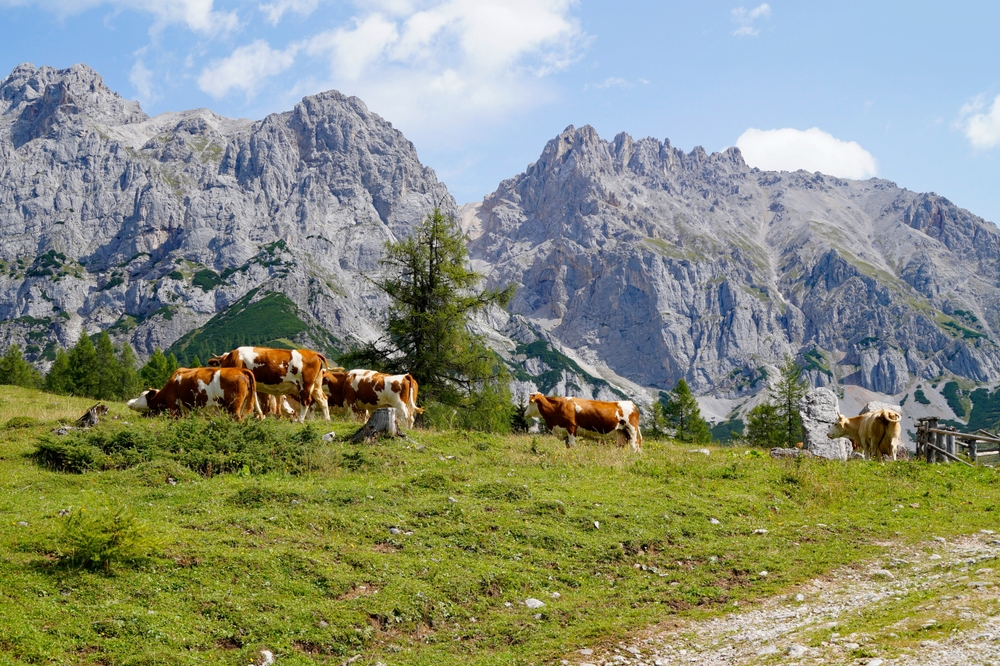
Schladming Dachstein Area, Austria:
The Schladming-Dachstein area in Austria’s Styria region is a celebrated hub for winter sports within the Ski Amadé network, Europe’s vast skiing region. Renowned for its four interconnected mountains – Hauser Kaibling, Planai, Hochwurzen, and Reiteralm – it offers a skiing haven in winter.
Summer transforms the area into a center for hiking, mountain biking, and climbing, with the Dachstein Glacier allowing year-round skiing and stunning alpine views. The region also showcases traditional Austrian culture, offering a glimpse into local customs, cuisine, and festivals.
How to Reach Schladming Dachstein Area:
Nestled in Styria, the area is approximately 90 minutes away by car from Salzburg, making it convenient for those flying into Mozart City.
Number of Days to Visit Schladming Dachstein Area:
Plan on staying at least four days to make the most of the outdoor adventures and regional attractions.
Tourist Attractions and Things to Do in Schladming Dachstein Area:
- Planai Ski Resort: A paradise for skiers and snowboarders.
- Dachstein Glacier: Offers year-round snow and an ice palace.
- Riesach Falls: Austria’s highest waterfall with a thrilling suspension bridge.
- Sky Walk: A glass-bottomed platform providing 360-degree views.
- Alpine Coaster: For a downhill thrill, this is an exhilarating experience.

